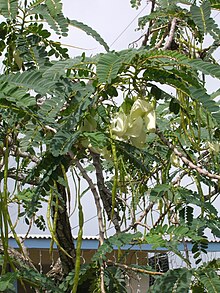Sesbania grandiflora
| Sesbania grandiflora | |
|---|---|

| |
| Scientific classification | |
| Kingdom: | |
| (unranked): | |
| (unranked): | |
| (unranked): | |
| Order: | |
| Family: | |
| Genus: | |
| Species: | S. grandiflora
|
| Binomial name | |
| Sesbania grandiflora (L.) Poiret
| |
| Synonyms | |
| |
Sesbania grandiflora (syn. Aeschynomene grandiflora, Agati grandiflora),[3] commonly known as vegetable hummingbird,[4] agati or hummingbird tree, is a small tree in the genus Sesbania.
Description
It is a fast-growing tree. The leaves are regular and rounded and the flowers white or red. The fruits look like flat, long, thin green beans. The tree thrives under full exposure to sunshine and is extremely frost sensitive.
It is a small soft wooded tree up to 3–8 m tall. Leaves are 15–30 cm long, with leaflets in 10–20 pairs or more and an odd one. Flowers are oblong, 1.5–10 cm long in lax, 2–4 flower racemes. The calyx is campanulate and shallowly 2-lipped. Pods are slender, falcate or straight, and 30–45 cm long, with a thick suture and approximately 30 seeds 8 mm in size.




| Nutritional value per 100 g (3.5 oz) | |||||||||||||||||||||||||||||||||
|---|---|---|---|---|---|---|---|---|---|---|---|---|---|---|---|---|---|---|---|---|---|---|---|---|---|---|---|---|---|---|---|---|---|
| Energy | 113 kJ (27 kcal) | ||||||||||||||||||||||||||||||||
6.73 g | |||||||||||||||||||||||||||||||||
0.04 g | |||||||||||||||||||||||||||||||||
1.28 g | |||||||||||||||||||||||||||||||||
| |||||||||||||||||||||||||||||||||
| †Percentages estimated using US recommendations for adults,[5] except for potassium, which is estimated based on expert recommendation from the National Academies.[6] | |||||||||||||||||||||||||||||||||
Origin and distribution
It is indigenous from Malaysia , Philippines to North Australia, and is cultivated in many parts of India and Sri Lanka. It has many traditional uses.[7] It grows where there is good soil and a hot, humid climate.
Medicinal uses
The leaf extract may inhibit the formation of advanced glycation end-products.[8] The leaf extract contains linolenic acid[9] and aspartic acid,[10] which were found to be the major compounds responsible for the anti-glycation potential of the leaf extract.
Culinary uses
The flowers of S. grandiflora are eaten as a vegetable in South Asia and Southeast Asia, including Laos, Thailand, Java in Indonesia, Vietnam, Sri Lanka, and the Ilocos Region of the Philippines.
In the Thai language, the flowers are called ดอกแค (dok khae) and are used in the cuisine both cooked in curries, such as kaeng som and kaeng khae,[11] and raw in nam phrik.[12]
The young pods are also eaten. In Sri Lanka, agati leaves, known as Katuru murunga in Sinhala language, are sometimes added to sudhu hodhi or white curry, a widely eaten, thin coconut gravy, and are believed locally to be a cure for canker sores. In India this plant is known as agati (Tamil), agastya (Kannada), agise (Telugu), and both the leaves and the flowers have culinary uses.
See also
- Sesbania bispinosa
- Dolichandrone spathacea, known as Dok khae thale in Thai
- Markhamia stipulata, known as Dok khae hua mu in Thai
- Edible flowers
- List of Thai ingredients
References
- ^ Prajapti, Purohit, Sharma, Kumar, A Handbook of medicinal plants, Agro Bios (India), Edition Ist 2003, Page.473
- ^ http://www.theplantlist.org/tpl/record/ild-24585
- ^ Joshi S. G., Medicinal Plants, Medicinal plants, Oxford & IBH Publishing Co. Pvt. Ltd. bks)
- ^ USDA, NRCS (n.d.). "Sesbania grandiflora". The PLANTS Database (plants.usda.gov). Greensboro, North Carolina: National Plant Data Team. Retrieved 10 November 2015.
- ^ United States Food and Drug Administration (2024). "Daily Value on the Nutrition and Supplement Facts Labels". FDA. Archived from the original on 2024-03-27. Retrieved 2024-03-28.
- ^ National Academies of Sciences, Engineering, and Medicine; Health and Medicine Division; Food and Nutrition Board; Committee to Review the Dietary Reference Intakes for Sodium and Potassium (2019). Oria, Maria; Harrison, Meghan; Stallings, Virginia A. (eds.). Dietary Reference Intakes for Sodium and Potassium. The National Academies Collection: Reports funded by National Institutes of Health. Washington, DC: National Academies Press (US). ISBN 978-0-309-48834-1. PMID 30844154. Archived from the original on 2024-05-09. Retrieved 2024-06-21.
- ^ Kirtikar K. R. & B. D. Basu, Indian Medicinal Plants Vol-I, International Book Distributor & Publisher, Dehradun, Edition 2005, bks pp. 735–736
- ^ https://www.thieme-connect.com/products/ejournals/abstract/10.1055/s-0033-1352426
- ^ Prasanna, Govindarajan (2016). "Linolenic acid prevents early and advanced glycation end-products (AGEs) modification of albumin". International Journal of Biological Macromolecules. 95: 121–125.
- ^ Prasanna, Govindarajan (2015). "Aspartic acid functions as carbonyl trapper to inhibit the formation of advanced glycation end products by chemical chaperone activity". Journal of Biomolecular Structure and Dynamics. 34 (5): 943–951.
- ^ Kaeng Khae Kai (Katurai Chilli Soup with Chicken)
- ^ Thailand Illustrated Magazine
External links
- Sesbania grandiflora on Tropicalforages.info
- Sesbania grandiflora in the AgroForestry Database of the World Agroforestry Centre
- Sesbania grandiflora on the FAO web site
- Sesbania grandiflora on the web site of the Center for New Crops & Plant Products at Purdue University.
- " Sesbania Seeds Exporter Kohenoor International Pakistan"
